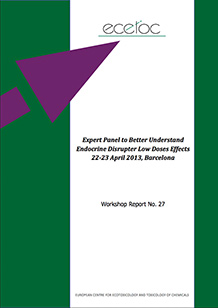Workshop Report 27 – Expert Panel to Better Understand Endocrine Disrupter Low Doses Effects
READ ONLINE1. This expert panel was convened by ECETOC to discuss the issue of so-called low dose effects of endocrine disrupting chemicals (EDC), and to propose a possible research programme to throw more light on this area.
2. Under the term 'low dose effects', the panel took into consideration subjects such as non-monotonic dose responses, the absence of thresholds for toxicity and the potential adverse effects resulting from the combined exposure of EDCs in the low concentration ranges. The panel considered these subjects and proposed suitable definitions.
3. The existence of 'low dose effects' is part of an unresolved debate among scientists, but has nevertheless been taken as a reason why traditional risk assessments of EDCs may be unreliable. It is therefore important that the presence of such effects should be firmly established or refuted and their implications for risk assessments fully investigated in order to provide risk assessors with a sound scientific foundation for their work.
4. On the combined exposure of EDCs it was considered that additive effects, rather than synergistic effects are to be expected in the low dose range and this topic was therefore not considered as a top priority to address in the first instance. The panel therefore, formulated two hypotheses which it considered needed to be tested in order to make progress in this subject.
a) The lack of a threshold means that the dose response relationships established for endocrine disrupters will show the adverse effect at any dose tested.
b) Non-monotonic responses in dose response relationships for endocrine active chemicals mean that it is not possible to anticipate adverse events using traditional approaches.
5. It was agreed that the only practical way to support or refute these hypotheses is through the use of mechanistic mode of action (MoA) models focusing on key events, their quantitative description and dose-response characteristic. Empirical or direct experimental approaches to test for thresholds are unlikely to be helpful for resolving this issue due to the unrealistically high statistical power which would be required to detect the very small effect sizes assumed to apply at low dose levels. However, in analogy to the lessons learnt with chemical carcinogens, the question of thresholds can be resolved by considering mechanism of carcinogenicity. Applied to endocrine disrupters, the idea would be to identify the key events for the mode of action of chemicals for which low-dose effects have been reported. These key events would range comprehensively from interaction with the molecular target to the ultimate adverse effect (i.e. the whole adverse outcome pathway). Each key event would then be fully characterised in terms of dose and time responses.
6. The key events will need to be characterised over a large range of doses, and the resulting datasets integrated through the use of mathematical modelling using a system biology approach. Such models would then be interrogated to investigate whether or not low dose and/or non-monotonic responses were indeed feasible.
7. It was agreed that before funding is sought for such a large research programme, it will be important for the control of the programme to be placed under the aegis of a neutral body such as the World Health Organisation (WHO) or the Organisation for Economic Cooperation and Development (OECD). This was considered essential in order to ensure maximum confidence in the findings.

